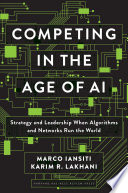

The book opens with the premise that we are in the midst of an AI revolution that is reshaping industries and economies. It emphasizes that AI is not just a tool but a foundational technology that can redefine business models. Companies that harness AI effectively can outperform their competitors by leveraging vast amounts of data to make informed decisions, optimize operations, and enhance customer experiences. The authors argue that AI enables organizations to operate at a scale and speed previously unimaginable, thus creating a competitive edge. They provide examples of companies that have successfully integrated AI into their operations, showcasing how these technologies can lead to significant improvements in efficiency and innovation.
Continue readingOne of the central themes of the book is the idea that data is a critical asset in the age of AI. The authors discuss how organizations must treat data not merely as a byproduct of operations but as a strategic resource. They highlight the importance of data governance, quality, and accessibility in enabling AI-driven insights. Companies that can collect, analyze, and leverage data effectively can create personalized experiences for customers, optimize their supply chains, and drive innovation. The book outlines strategies for building a data-centric culture, emphasizing the need for collaboration across departments to ensure that data is utilized to its fullest potential.
Continue readingThe authors argue that traditional business models focused on selling products are becoming obsolete in the age of AI. Instead, they advocate for a shift towards platform-based business models that facilitate interactions between users and providers. These platforms leverage AI to create value by connecting various stakeholders and enabling data exchange. The book provides examples of successful platform companies, illustrating how they have redefined industries by creating ecosystems that foster collaboration and innovation. The authors emphasize that businesses must rethink their value propositions and explore how they can create platforms that enhance user experiences and drive engagement.
Continue readingLeadership plays a crucial role in the successful adoption of AI within organizations. The authors stress that leaders must not only understand the technology but also foster a culture that embraces change and innovation. They discuss the importance of building cross-functional teams that can collaborate on AI initiatives and drive strategic alignment. The book highlights the need for leaders to invest in talent development and create an environment where experimentation and learning are encouraged. By doing so, organizations can better navigate the complexities of AI implementation and position themselves for long-term success.
Continue readingAs AI technologies become more pervasive, ethical considerations surrounding their use become increasingly important. The authors address the potential risks and challenges associated with AI, including bias, privacy concerns, and job displacement. They argue that organizations must take a proactive approach to ethics by establishing guidelines and frameworks for responsible AI use. The book emphasizes the need for transparency and accountability in AI decision-making processes, urging companies to consider the societal implications of their technologies. By prioritizing ethical considerations, organizations can build trust with stakeholders and mitigate potential backlash.
Continue readingIn the rapidly evolving landscape of AI, organizations must commit to continuous learning and adaptation. The authors highlight that the pace of technological change requires businesses to be agile and responsive to emerging trends. They advocate for a culture of experimentation where organizations can test new ideas and iterate based on feedback. The book discusses the importance of investing in ongoing training and upskilling for employees to ensure they are equipped to leverage AI effectively. By fostering a mindset of adaptability, organizations can position themselves to thrive in an unpredictable future.
Continue readingThe final key idea explores the implications of AI on the workforce. The authors discuss how AI will transform job roles and the nature of work itself. While some jobs may be displaced by automation, new opportunities will arise as AI creates demand for skills that complement technology. The book emphasizes the importance of reskilling and upskilling the workforce to prepare for these changes. The authors argue that organizations must take an active role in supporting their employees through this transition, fostering a culture of lifelong learning to ensure that individuals can adapt to the evolving job landscape.
Continue reading